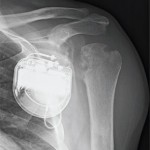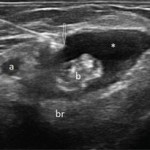Findings/Diagnosis
The AP radiograph of the left shoulder (see Figure 1) shows erosions of the proximal humeral and glenoid articular surfaces (black arrows) without joint-space narrowing. There is a well-defined marginal erosion with overhanging edge at the junction of the proximal humeral articular surface and rotator cuff insertion on the greater tuberosity (ellipse). There is focal lateral soft tissue swelling (white arrow).
The ultrasound image over the proximal left humerus (see Figure 2) shows the long-head biceps tendon in transverse orientation (black arrow) with distension of the biceps tendon sheath by a heterogeneous, predominantly hypoechoic mass (left of biceps tendon). There is a cortical erosion in the bicipital groove (white arrow). There is marked distension of the overlying subacromial-subdeltoid bursa with a heterogeneous, partially compressible solid and cystic mass (ellipse).
Based on these findings and the patient’s history of end-stage renal disease, the differential diagnosis included septic arthritis, amyloidosis and gout. Aspiration and biopsy of the mass (see Figure 3) revealed turbid fluid with 98% polymorphonuclear cells. Gram stain and cultures were negative. Surgical pathology was consistent with acute inflammation and tissue necrosis, with negative Congo red stain (excluding amyloidosis). Crystal analysis revealed negative birefringent uric acid crystals, diagnostic of gout.
Gout arthritis can occur in any joint of the body. As in this case, patients with chronic renal insufficiency frequently have hyperuricemia and may develop gout, often in uncommon locations. Although the imaging findings are fairly characteristic, with well-defined marginal erosions with overhanging edges and relative preservation of the joint space until the late stages of disease, biopsy and/or aspiration may be indicated to confirm the diagnosis.
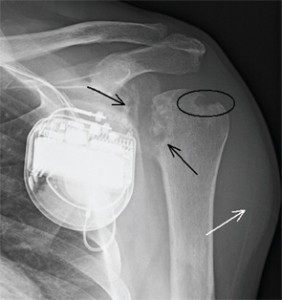
Figure 1: AP radiograph of the left shoulder.
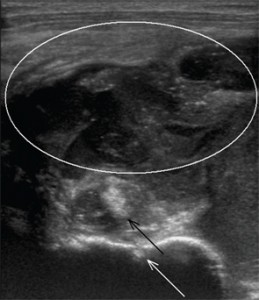
Figure 2: Transverse sonographic image of the left shoulder.
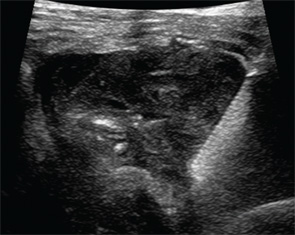
Figure 3: Transverse sonographic image of the left shoulder during aspiration and biopsy.
Jennifer L. Demertzis, MD, is a musculoskeletal radiologist at the Mallinckrodt Institute of Radiology at Washington University School of Medicine in St. Louis, Mo. She is excited to collaborate on this new feature in the journal and looks forward to seeing future cases contributed by readers.
Send Us Your Images
Contact us at:
Keri Losavio
editor
E-mail: [email protected]
